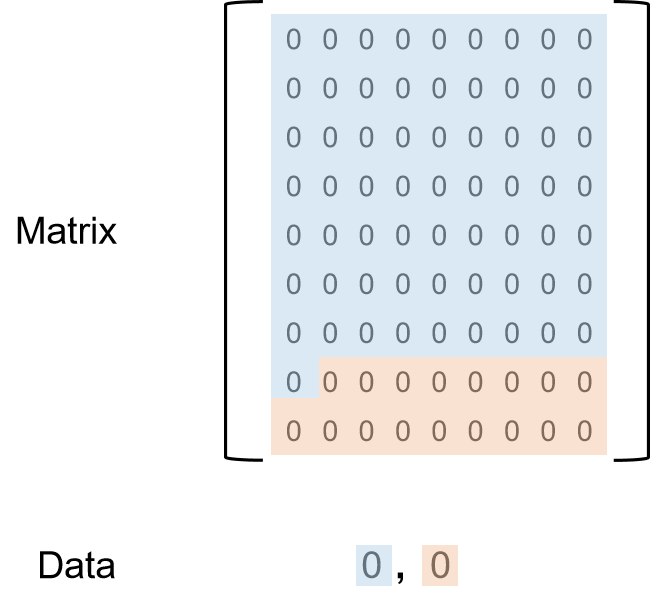使用位运算实现布尔矩阵
0x0. 情景
先说明什么是布尔矩阵:值为bool或者仅包含01的二维矩阵。 假定一个场景:现有一个840×840大小的瓦片地图,在服务端使用二维矩阵存储,如果直截了当开一个840×840的二维数组bool mapData[840][840],这样显然是有些蛋疼的。 这样暴力的方式显然不能够应用到生产环境中去,这里的例子还只是一个840大小的矩阵,如果更大到8400×8400那就更加无法应用了。
0x1. 原理
这里提出一种方式来存储这样的矩阵,其主要思想是使用二进制的优势,将独立的bool数据放到数字类型中的某一位去做,将整个矩阵按照行主序存储在一个一维数组中。
这里以一个9×9矩阵并且使用int64_t作为数据存储格式为例,则只需要一个长度为2的int64_t数组即可存下所有的数据,其数据分布如下:
 其中第一位数表示了矩阵中的前64位数据,第二位数表示了矩阵中的后面所有数据。对于每一个数,则可以使用位掩码(bit-mask)方式来操作。
以9×9矩阵为例,使用二维数组需要9×9×sizeof(bool) = 81bytes数据,如果使用位运算压缩存储,则只需要2×sizeof(uint64_t) = 16bytes数据,其数据只有二维数组的12.5%。
其中第一位数表示了矩阵中的前64位数据,第二位数表示了矩阵中的后面所有数据。对于每一个数,则可以使用位掩码(bit-mask)方式来操作。
以9×9矩阵为例,使用二维数组需要9×9×sizeof(bool) = 81bytes数据,如果使用位运算压缩存储,则只需要2×sizeof(uint64_t) = 16bytes数据,其数据只有二维数组的12.5%。
0x2. 代码实现
// BoolMatrix.hpp
#pragma once
#include <vector>
#include <tuple>
#include <cmath>
class BoolMatrix
{
public:
BoolMatrix(int rowSize, int colSize, bool defaultVal = false)
: row(rowSize), col(colSize)
{
if (row <= 0 || col <= 0)
return;
int size = ceil(row * col / 1.0 / MAX_BIT_COUNT);
data = std::vector<int64_t>(size, defaultVal ? 1 : 0);
}
~BoolMatrix() = default;
// get matrix cell value
bool Get(int x, int y)
{
if (x < 0 || x >= row || y < 0 || y >= col)
throw "index out of range!";
int idx, bit;
std::tie(idx, bit) = GetIndexAndBit(x, y);
auto val = 1 & (data[idx] >> bit);
return val != 0;
}
// set matrix cell value to true
void Set(int x, int y)
{
if (x < 0 || x >= row || y < 0 || y >= col)
throw "index out of range!";
int idx, bit;
std::tie(idx, bit) = GetIndexAndBit(x, y);
data[idx] = data[idx] | (1ll << bit);
}
// set matrix cell value to false
void Unset(int x, int y)
{
if (x < 0 || x >= row || y < 0 || y >= col)
throw "index out of range!";
int idx, bit;
std::tie(idx, bit) = GetIndexAndBit(x, y);
data[idx] = data[idx] & ~(1ll << bit);
}
// flip matrix cell value
void Flip(int x, int y)
{
if (x < 0 || x >= row || y < 0 || y >= col)
throw "index out of range!";
int idx, bit;
std::tie(idx, bit) = GetIndexAndBit(x, y);
data[idx] = data[idx] ^ (1ll << bit);
}
// unfold matrix
std::vector<std::vector<bool>> GetMatrix()
{
std::vector<std::vector<bool>> mat{};
for (size_t x = 0; x < row; ++x)
{
std::vector<bool> rowData{};
for (size_t y = 0; y < col; ++y)
{
rowData.push_back(Get(x, y));
}
mat.push_back(rowData);
}
return mat;
}
private:
int row = 0;
int col = 0;
std::vector<int64_t> data{};
const int MAX_BIT_COUNT = 64;
private:
std::tuple<int, int> GetIndexAndBit(int x, int y)
{
int coord = x * col + y;
int index = coord / MAX_BIT_COUNT;
return std::make_tuple(index, coord - index * MAX_BIT_COUNT);
}
};